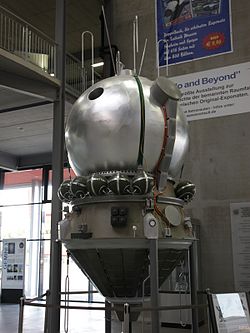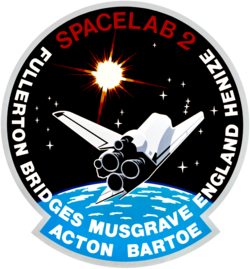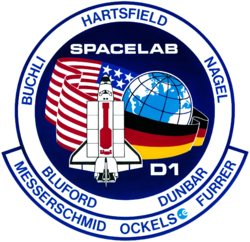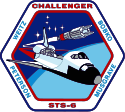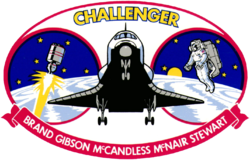Challenger (rymdfärja)
- För andra betydelser, se Challenger.
| Challenger OV-099 | |
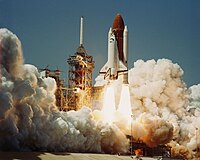 Challenger skjuts upp på dess första uppdrag, STS-6. | |
| OV-beteckning | OV-099 |
|---|---|
| Land | USA |
| Kontraktstilldelning | 1 januari 1979 |
| Namngiven efter | HMS Challenger |
| Status | Exploderade 28 januari 1986 |
| Första flygning | STS-6 4–9 april 1983 |
| Sista flygning | STS-51-L 28 januari 1986 |
| Antal uppdrag | 10 |
| Tid i rymden | 62 dagar 07:56:22[1] |
| Antal genomförda omloppsvarv | 995 |
| Tillryggalagd sträcka | 41 527 414 km |
| Satelliter utplacerade | 10 |
Challenger (OV-99) var den andra av den amerikanska rymdflygstyrelsen Nasas rymdfärjor som togs i bruk, efter Columbia. Dess jungfruresa skedde den 4 april 1983. Challenger hann göra nio uppdrag innan den exploderade under uppskjutningen den 28 januari 1986.
Den uppkallades efter HMS Challenger, som användes vid Challengerexpeditionen.
Uppdrag

Rymdfärjan Challenger utförde tio flygningar, tillbringade 62,41 dagar i rymden, gjorde 995 varv runt jorden och flög totalt 41 527 416 kilometer inklusive det sista uppdraget.
Olyckan
Den 28 januari 1986 sköts rymdfärjan Challenger iväg för sin tionde rymdfärd. Uppdragets beteckning var STS-51-L, och omfattade diverse vetenskapliga experiment. Starten hade ursprungligen varit planerad till den 22 januari men fick skjutas upp flera gånger på grund av tekniska problem och dålig väderlek. Avfyrningen skulle egentligen börja kl. 10.38 men på grund av kallt väder fördröjdes starten till kl. 11.38 när Challenger lyfte. Starten gick först enligt planerna, men efter 73 sekunder exploderade rymdfärjan ovanför Kennedy Space Center. Alla sju ombordvarande omkom. Åtminstone en del av besättningen överlevde branden och färjans sönderfall, men omkom när den förstärkta del av rymdfärjan som de befann sig i störtade i havet. Läraren Christa McAuliffe, en av de ombordvarande astronauterna, skulle blivit den första läraren i rymden, och många skolelever såg den direktsända uppskjutningen på TV.[2]
Efter olyckan tillsattes en kommission under ordföranden William Rogers för att undersöka orsakerna bakom explosionen. Bland de 14 som satt i Rogers Commission Report kan nämnas fysikern och nobelpristagaren Richard Feynman, förste mannen på månen Neil Armstrong, första amerikanska kvinnan i rymden Sally K. Ride och testpiloten Chuck Yeager.
"The Rogers Commission Report" kom fram till flera orsaker som hade bidragit till olyckan. För det första konstaterade man att gummipackningarna (O-ringar) som utgjorde trycktätning mellan lyftraketernas olika sektioner hade försvagats vilket ledde till att gas började strömma ut vilket i sin tur förstörde rymdfärjan. Defekten syns på bilderna från starten där man ser hur små svarta rökmoln bildas vid den högra lyftraketen. En orsak bakom denna defekt var det kalla vädret den dagen som hade bidragit till att gummipackningarna inte höll tätt. Rakettillverkaren Morton Thiokols ingenjörer hade motsatt sig en start på grund av de låga temperaturerna men NASA bestämde sig för att strunta i ingenjörernas åsikter och att genomföra starten ändå. Här slog "Rogers Commission" även fast att NASA hade sänkt sina krav på säkerhet till en väldigt låg nivå. Rapporten konstaterade även att NASA ville genomföra för många flygningar i relation till materialet och personalen som det hade till sitt förfogande. Därmed hade organisationen inga resurser för att motverka oförutsedda materialproblem.[3]

Efter olyckan diskuterade man att bygga om testfärjan Enterprise till en fullt fungerande rymdfärja, men man kom slutligen fram till att det skulle bli billigare att bygga en ny. Den nya färjan fick namnet Endeavour.
Sjutton år senare havererade även rymdfärjan Columbia.
Rymdfärdsuppdragen
| Färd | Uppdrag | Startdatum | Landning | Färdens tid |
|---|---|---|---|---|
| 1 | STS-6 | 4 april 1983 | 9 april 1983 | 120:23:42 |
| 2 | STS-7 | 18 juni 1983 | 24 juni 1983 | 146:23:59 |
| 3 | STS-8 | 30 augusti 1983 | 5 september 1983 | 145:08:43 |
| 4 | STS-41-B | 3 februari 1984 | 11 februari 1984 | 191:15:55 |
| 5 | STS-41-C | 6 april 1984 | 13 april 1984 | 167:40:07 |
| 6 | STS-41-G | 5 oktober 1984 | 13 oktober 1984 | 197:23:38 |
| 7 | STS-51-B | 29 april 1985 | 6 maj 1985 | 168:08:46 |
| 8 | STS-51-F | 29 juli 1985 | 6 augusti 1985 | 190:45:26 |
| 9 | STS-61-A | 30 oktober 1985 | 6 november 1985 | 168:44:53 |
| 10 | STS-51-L | 28 januari 1986 | Haveri | 0:01:13 |
| Uppdragsemblem för Challengers flygningar | |||||||
|---|---|---|---|---|---|---|---|
 |  |  |  |  | |||
 |  |  |  |  | |||
Referenser
- Den här artikeln är helt eller delvis baserad på material från engelskspråkiga Wikipedia, tidigare version.
- ^ Harwood, William (12 oktober 2009). ”STS-129/ISS-ULF3 Quick-Look Data” (på engelska). CBS News. http://www.cbsnews.com/network/news/space/129/129quicklook2.pdf. Läst 30 november 2009.
- ^ ”Challengerkatastrofen: Astronauterna visste att de skulle dö”. illvet.se. https://illvet.se/universum/rymdresor/challenger-katastrofen-astronauter-visste-att-de-skulle-do. Läst 6 april 2020.
- ^ Upi (10 juni 1986). ”The Shuttle Findings: A Long Series of Failures; Key Portions of Commission Report on Challenger Accident” (på amerikansk engelska). The New York Times. ISSN 0362-4331. https://www.nytimes.com/1986/06/10/science/shuttle-findings-long-series-failures-key-portions-commission-report-challenger.html. Läst 7 april 2020.
Externa länkar
 Wikimedia Commons har media som rör Challenger (rymdfärja).
Wikimedia Commons har media som rör Challenger (rymdfärja).- NASA - Challenger (OV-99)
- Haverirapporten
| ||||||||
| |||||||||||
| ||||||||||||||||||||||||||||||||
Media som används på denna webbplats
Författare/Upphovsman: Pascal (Flickr user: pasukaru76), Licens: CC0
Vostok spacecraft replica at the Technik Museum Speyer, Germany.
STS-51-L INSIGNIA
- Members of the STS-51L crew designed this patch which will represent their participation on NASA's late January 1986 mission aboard the space shuttle Challenger, depicted launching from Florida and soaring into space to carry out a variety of goals. Among the prescribed duties of the five astronauts and two payload specialists will be observation and photography of Halley's Comet, backdropped against the United States flag in the insignia. Surnames of the crew members encircle the scene, with the payload specialists being recognized below. Surname of the first teacher in space, Sharon Christa McAuliffe, is followed by a symbolic apple. Gregory Jarvis, representing Hughes, is the industrial payload specialist for the flight. NASA's crew members are astronauts Francis R. (Dick) Scobee, commander; Michael J. Smith, pilot; and Ronald E. McNair, Ellison S. Onizuka and Judith A. Resnik - all mission specialists.
STS-51F Mission Insignia
- The crewmembers of Space Shuttle mission 51-F have chosen as their insignia this design by Houston artist Skip Bradley. The Space Shuttle Challenger is depicted ascending toward the heavens in search of new knowledge in the field of solar and stellar astronomy, with its Spacelab 2 payload. The constellations Leo and Orion are in the positions they will be in, relative to the sun during the flight. The nineteen stars signify that this will be the 19th STS flight. Crewmembers for the mission are Astronauts C. Gordon Fullerton, commander; Roy D. Bridges, pilot; F. Story Musgrave, Anthony W. England, and Karl J. Henize, mission specialist; and Payload Specialists Loren W. Acton and John David Bartoe.
STS-8 INSIGNIA --- The night launch of Challenger heading toward its third earth-orbital mission is featured in the official insignia for STS-8. The eighth flight of the United States Space Transportation System is represented by eight stars of the constellation Aquila, "The Eagle," Astronauts Richard H. Truly, commander; Daniel C. Brandenstein, pilot; Dale A. Gardner, Guion S. Bluford, and William E. Thornton--all mission specialists--have their sumames on the border of the insignia.
PHOTO CREDIT: NASA or National Aeronautics and Space Administration- Short Description: Space Shuttle Challenger explodes shortly after take-off.
- Full Description: On January 28, 1986, the Challenger space shuttle and her seven-member crew were lost when a ruptured O-ring in the right solid rocket booster caused an explosion soon after launch. This photograph, taken a few seconds after the accident, shows the main engines and solid rocket booster exhaust plumes entwined around a ball of gas from the external tank. Because shuttle launches had become almost routine after 24 successful missions, those watching the shuttle launch in person and on television found the sight of the explosion especially shocking and difficult to believe until NASA confirmed the accident.
- Image # : 86-HC-220
- Title: Exhaust Trail of STS-51-L
Space Transportation System Number 6, Orbiter Challenger, lifts off from Pad 39A carrying astronauts Paul J. Weitz, Koral J. Bobko, Donald H. Peterson and Dr. Story Musgrave.
Mission patch for the STS-7 mission.
Diagram of the Space Shuttle Solid Rocket Booster field joint assembly. The top end of the lower rocket segment has a deep U-shaped cavity, or clevis, along its circumference. The bottom end of the top segment extends to form a tang that fits snugly into the clevis of the bottom segment. A series of holes through the outer branch of the clevis, through the tang and part way into the clevis inner branch, hold thick pins that lock the segments together. An outer band holds the pins in place. Two parallel grooves on the clevis inner branch hold O-rings that seal the gap between the tang and the clevis, keeping hot gases out.
STS-61A Mission Insignia
- This insignia was chosen by the eight members of the STS-61A/D1 Spacelab mission to represent the record-sized Space Shuttle crew. Crewmembers surnames surround the colorful patch scene depicting Challenger carrying a long science module and an international crew from Europe and the United States.
STS-6 Crew Insignia
The patch features a helmet visor of an astronaut performing an extravehicular activity. In the visor are reflected the sun's rays, the Challenger and its remote manipulator system (RMS) deploying the long duration exposure facility (LDEF), the Earth and blue sky, and another astronaut working at the damaged Solar Maximum Satellite (SMS). The scene is encircled by the surnames of the crewmembers.


